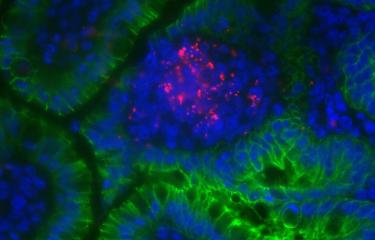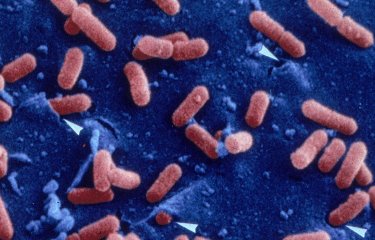A study conducted by the group directed by Marc Lecuit (Avenir Inserm / Group Microorganisms and barriers host the Pasteur Institute), at the Inserm unit U604 directed by Pascale Cossart, has uncovered how the bacterium responsible for Listeriosis (Listeria monocytogenes) can cross the placenta of pregnant women to cause serious fetal infections —even death—, premature birth and infections in newborns. This is the first time the molecular mechanism allowing a pathogenic bacterium to cross the placenta in vivo is discovered. This work is published on September 17 on Nature's website.
Press release
Paris, september 17, 2008
Listeriosis is a bacterial infection caused by food-borne Listeria monocytogenes. Widespread in nature (water, soil, plants, animals) that bacteria can contaminate many foods: raw vegetables, ready-to-eat cooked dishes, cheese, meats and threatens primarily pregnant women, children and unborn newborns. The elderly and immunocompromised are also at risk. Among them listeriosis is responsible for septicemia, meningitis and encephalitis. Antibiotics are in most cases effective but the infection is nevertheless still lethal in 20 to 30% of infected individuals. In healthy adults, symptoms are generally less severe and can result in a simple gastroenteritis.
The infection begins with ingestion of food contaminated with Listeria monocytogenes, which can then cross the intestinal barrier and reach the bloodstream. The bacterium is then able to cross the barrier between the blood vessels of the brain (blood-brain barrier) or cross the placenta to disseminate to the fetus in pregnant women.
Marc Lecuit, Pascale Cossart and their colleagues at the Institut Pasteur, INSERM and INRA have developed the first two animal models for human listeriosis allowing to study the crossing of the placental barrier in vivo: the gerbil, a rodent naturally susceptible to Listeria monocytogenes, and a new mouse by genetically modified by "knock-in". This mouse expresses a human adhesion protein on the surface of epithelial cells called E-cadherin. With these two animal models, researchers were able to identify that two Listeria proteins, called InlA and InlB, interact with specific receptors, respectively E-cadherin and Met, which allow them to adhere to the placenta and cross it to reach the fetus.
Researchers had previously studied in vitro interactions of these proteins with their receptors and showed (Science, 2001) how Listeria crosses the intestinal barrier, but this is the first time the molecular mechanism allowing a pathogenic bacterium to cross the placental barrier in vivo is discovered.
This work greatly improves our understanding of the pathogenicity of Listeria monocytogenes and may lead to the development of molecules capable of preventing the spread of Listeria to the fetus, by inhibiting host-bacterial interactions. Understanding the mechanism of crossing the placenta could also help deliver therapeutic molecules across the placental barrier.
The teams of Marc Lecuit and Pascale Cossart work together to understand the mechanism of the crossing the blood-brain barrier by Listeria monocytogenes. Their working hypothesis is that these same proteins could also play a role in the infection of the central nervous system.
Source
“Conjugated action of two species-specific invasion proteins for fetoplacental listeriosis”, Nature, 17 septembre 2008.
Olivier Disson 1,2*, Solène Grayo 1,2,3*, Eugénie Huillet 4,5,6*, Georgios Nikitas 1,2, Francina Langa-Vives 7, Olivier Dussurget 4,5,6, Marie Ragon 3, Alban Le Monnier 3, Charles Babinet 8‡, Pascale Cossart 4,5,6 & Marc Lecuit 1,2,3,9
1 Institut Pasteur, Groupe Microorganismes et Barrières de l’Hôte, Unité des Interactions Bactéries-Cellules, F-75015, Paris, France.
2 Inserm Avenir U604, F-75015, Paris, France.
3 Institut Pasteur, Centre de Référence des Listeria, F-75015, Paris, France.
4 Institut Pasteur, Unité des Interactions Bactéries-Cellules, F-75015, Paris, France.
5 Inserm U604, F-75015, Paris, France.
6 INRA USC2020, F-75015, Paris, France.
7 Institut Pasteur, Centre d’Ingénierie Génétique Murine, F-75015, Paris, France.
8 Institut Pasteur, Unité de Biologie du Développement, F-75015, Paris, France.
9 Centre d’Infectiologie Necker-Pasteur, Service des Maladies Infectieuses et Tropicales, Hôpital Necker-Enfants malades, Assistance Publique-Hôpitaux de Paris, Université Paris Descartes, F-75015, Paris, France.
Press contacts
Institut Pasteur press office
Marion Doucet ou Nadine Peyrolo
+33 (0)1 45 68 89 28 – marion.doucet@pasteur.fr
Inserm press office
Anne Mignot
+33 (0)1 44 23 60 73 – anne.mignot@inserm.fr




